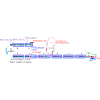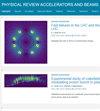Machine-learning approach for operating electron beam at KEK electron/positron injector linac
IF 1.8
3区 物理与天体物理
Q3 PHYSICS, NUCLEAR
Physical Review Accelerators and Beams
Pub Date : 2024-08-26
DOI:10.1103/physrevaccelbeams.27.084601
引用次数: 0
Abstract
In current accelerators, numerous parameters and monitored values are to be adjusted and evaluated, respectively. In addition, fine adjustments are required to achieve the target performance. Therefore, the conventional accelerator-operation method, in which experts manually adjust the parameters, is reaching its limits. We are currently investigating the use of machine learning for accelerator tuning as an alternative to expert-based tuning. In recent years, machine-learning algorithms have progressed significantly in terms of speed, sensitivity, and application range. In addition, various libraries are available from different vendors and are relatively easy to use. Herein, we report the results of electron-beam tuning experiments using Bayesian optimization, a tree-structured Parzen estimator, and a covariance matrix-adaptation evolution strategy. Beam-tuning experiments are performed at the KEK injector Linac to maximize the electron-beam charge and reduce the energy-dispersion function. In each case, the performance achieved is comparable to that of a skilled expert.

KEK 电子/正电子喷射器直列加速器电子束操作的机器学习方法
在当前的加速器中,有许多参数和监测值需要分别进行调整和评估。此外,为了达到目标性能,还需要进行微调。因此,由专家手动调整参数的传统加速器操作方法已达到极限。目前,我们正在研究使用机器学习进行加速器调整,以替代基于专家的调整。近年来,机器学习算法在速度、灵敏度和应用范围方面都取得了显著进步。此外,不同供应商还提供了各种库,而且相对容易使用。在此,我们报告了使用贝叶斯优化、树状结构的帕尔森估计器和协方差矩阵适应演化策略进行电子束调谐实验的结果。电子束调谐实验是在 KEK e-/e+ 注入器直列加速器上进行的,目的是使电子束电荷最大化并降低能量分散函数。在每种情况下,所取得的性能都可与熟练专家的性能相媲美。
本文章由计算机程序翻译,如有差异,请以英文原文为准。
求助全文
约1分钟内获得全文
求助全文
来源期刊

Physical Review Accelerators and Beams
Physics and Astronomy-Surfaces and Interfaces
CiteScore
3.90
自引率
23.50%
发文量
158
审稿时长
23 weeks
期刊介绍:
Physical Review Special Topics - Accelerators and Beams (PRST-AB) is a peer-reviewed, purely electronic journal, distributed without charge to readers and funded by sponsors from national and international laboratories and other partners. The articles are published by the American Physical Society under the terms of the Creative Commons Attribution 3.0 License.
It covers the full range of accelerator science and technology; subsystem and component technologies; beam dynamics; accelerator applications; and design, operation, and improvement of accelerators used in science and industry. This includes accelerators for high-energy and nuclear physics, synchrotron-radiation production, spallation neutron sources, medical therapy, and intense-beam applications.
 求助内容:
求助内容: 应助结果提醒方式:
应助结果提醒方式:


